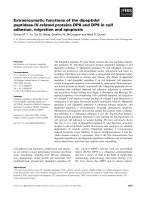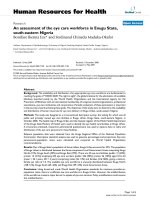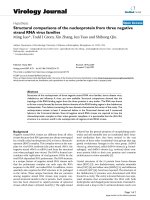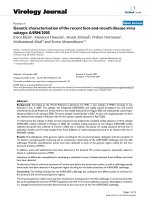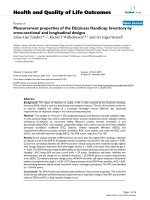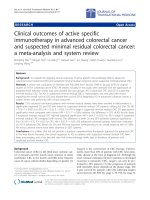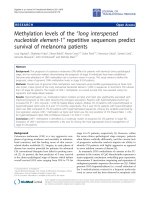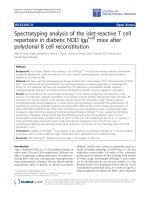Báo cáo sinh học: "Bisphosphonate-associated osteonecrosis of the jaw is linked to suppressed TGFb1-signaling and increased Galectin-3 expression: A histological study on biopsies" pot
Bạn đang xem bản rút gọn của tài liệu. Xem và tải ngay bản đầy đủ của tài liệu tại đây (2.01 MB, 11 trang )
RESEARC H Open Access
Bisphosphonate-associated osteonecrosis of the
jaw is linked to suppressed TGFb1-signaling and
increased Galectin-3 expression: A histological
study on biopsies
Falk Wehrhan
1*
, Peter Hyckel
2
, Arndt Guentsch
3
, Emeka Nkenke
1
, Phillip Stockmann
1
, Karl A Schlegel
1
,
Friedrich W Neukam
1
and Kerstin Amann
4
Abstract
Background: Bisphosphonate associated osteonecrosis of the jaw (BRONJ) implies an impairment in oral hard- and
soft tissue repair. An understanding of the signal transd uction alterations involved can inform therapeutic
strategies. Transforming growth factor b1 (TGFb1) is a critical regulator of tissue repair; galectin-3 mediates tissue
differentiation and specifically modulates periodontopathic bacterial infection. The aim of this study was to
compare the expression of TGFb1-related signaling molecules and Galectin-3 in BRONJ-affected and healthy
mucosal tissues. To discriminate between BRONJ-specific impairments in TGFb1 signaling and secondary
inflammatory changes, the results were compared to the expression of TGFb1 and Galectin-3 in mucosal tissues
with osteoradionecrosis.
Methods: Oral mucosal tissue samples with histologically-confirmed BRONJ (n = 20), osteoradionecrosis (n = 20),
and no lesions (normal, n = 20) were processed for immunohistochemistry. Automated staining with an alkaline
phosphatase-anti-alkaline phosphatase kit was used to detect TGFb1, Smad-2/3, Smad-7, and Galectin-3. We
semiquantitatively assessed the ratio of stained cells/total number of cells (labeling index, Bonferroni-adjustment).
Results: TGFb1 and Smad-2/3 were significantly decreased (p < 0.032 and p(0.028, respectively) in the BRONJ
samples and significantly increased (p < 0.04 and p <0.043, respectively) in the osteoradionecrosis samples compared
to normal tissue. Smad-7 was significantly increased (p < 0.031) in the BRONJ group and significantly decreased (p <
0.026) in the osteoradionecrosis group. Galectin-3 staining was significantly (p < 0.025) increased in both the BRONJ
and the osteoradionecrosis (p < 0.038) groups compared to the normal tissue group. However, Galectin-3 expression
was significantly higher in the BRONJ samples than in the osteoradionecrosis samples (p < 0.044).
Conclusion: Our results showed that disrupted TGFb1 signaling was associated with delayed periodontal repair in
BRONJ samples. The findings also indicated that impairments in TGFb1-signaling were different in BRONJ
compared to osteoradionecrosis. BRONJ appeared to be associat ed with increased terminal osseous differentiation
and decreased soft tissue proliferation. The increase in Galectin-3 reflected the increase in osseous differentiation of
mucoperiosteal progenitors, and this might explain the inflammatory anergy observed in BRONJ-affected soft
tissues. The results substantiated the clinical success of treating BRONJ with sequestrectomy, followed by strict
mucosa closure. BRONJ can be further elucidated by investigating the specific intraoral osteoimmunologic status.
Keywords: BRONJ, oral soft tissue, transforming growth factor beta 1, galectin-3, oral surgery
* Correspondence:
1
Department of Oral and Maxillofacial Surgery University of Erlangen-
Nuremberg, Germany
Full list of author information is available at the end of the article
Wehrhan et al. Journal of Translational Medicine 2011, 9:102
/>© 2011 Wehrhan et al; licensee BioMed Central L td. This is an Open Access article distributed under the terms of the Cre ative
Commons Attribution License ( which permits unrestricted use, distribu tion, and
reproduction in any medium , provided the original work is properly cited.
Introduction
Numerous attempts have been made to explain the
developm ent of bispho sphonate-associated osteonecrosis
of the jaw (BRONJ), but the formal pathology remains
unknown [1]. Previous studies have described the con-
cordance of local BRONJ and an inflammatory reaction
that was induced by an intraoral, gram-negative bacteria
superinfection of the tissue [1,2].Alternatively,thereis
increasing evidence that BRONJ is caused by bispho-
sphonate (BP)-related impairment of the interplay
among osteoblasts, osteoclasts, fibroblasts, and keratino-
cytes during tissue remodeling. However, it remains
unclear whether BRONJ a rises from a laceration in the
oral mucosa or from the underlying jaw bone tissue [1].
Recently, BRONJ was related to an impairment in Msx-
1-related osteoblast proliferation [3]. However, results
are contradictory regarding the biologic impact of BP on
periodontal epithelial and connective tissue cells. BP gel
formulations, topically applied in periodontal lesions,
have not caused adverse effects [4]. In contrast, when
alendronate tablets were held under a denture in contact
with the oral mucosa, necrosis occurred [5]. BP was
shown t o stimulate bone prog enitor cells toward osteo-
genesis in vitro [6]. In addition, the administration of
zoledronic acid to oral gingival fibroblasts in vitro
reduced expression of extracellular matrix (ECM) pro-
teins, including collagens I, II, and III [7].
Transforming growth factor b1(TGFb1) is a pleiotro-
pic cytokine that mediates fibroblast differentiation and
proliferation and regulates the epithelial-to-mesenchy-
mal transition (EMT) during wound repair {Huminiecki,
2009 #3987}. TGFb1 exerts its intracellular actions
through Smad protein signaling. Smad 2/3 was identified
as the downstream TGFb1 effector, and Smad 7 inhib-
ited intracellular TGFb1-related signaling [8]. Increased
TGFb1 and Smad-2/3 expression was shown to be
related to fibrocontractive wound healing d isorders [9].
Loss of TGFb1 has been implicated in dela yed wound
healing and impaired ECM deposition [10]. TGFb1was
shown to differentially affect epithelial and fibrous con-
nective tissues; it inhibited the migration of epithelial
cells during wound healing, but stimulated proliferation
of fibroblasts [11] TGF b1 and Smad signaling were
shown to be involved in both osseous and connective
tissue remodeling; thus, BP-related alterations in TGFb1
signaling might explain BP-associated changes in the
oral mucosa tissues of BRONJ affected jaws {Wu, 2009
#3990}. Furth ermore, osteoradionecrosis has been asso-
ciated with increased TGFb1 expression [12].
BP-related changes in Smad-2/3 expression may also
affect Smad activation by the glycoprotein, Galectin-3, in a
TGFb1- independent pathway [13]. Galectin-3 is involved
in the regulation of epithelial and bone differentiation and
plays a pivotal role in inflammatory responses and fibrotic
tissue remodeling; it has been shown to inhibit the activa-
tion of cytokines by pe riodontopathic gram negative bac-
teria [14-16]. Galectin-3 expression was increased in
radiation-impaired epithelial tissues. Galctin-3 expression
in squamous epithelial tissues was positively a ssociated
with differentiation and negatively associated with prolif-
eration {Szabo, 2009 #4519}. Therefore, the roles of
TGFb1 a nd Galectin-3 in cellular differentiation, tissue
regeneration, and inflammation may be relevant to the
mechanisms underlying BRONJ.
The American Society for Bone and Mineral Research
has formed a BRONJ-task force that requires clinical
and basic research in jaw-specific biology [17]. This
study aimed to compare the cellular expression levels of
TGFb1, Smad 2/3, Smad 7, and Galectin 3 in BRONJ-
related periodontal tissues compared to healthy oral
mucosa. We assessed the impact of BP-therapy on the
spatial distribution and protein expression of TGFb1
sig naling mol ecules and Galectin-3 in BRONJ sites with
semiquan titative immunohistochemical analysis . To dis-
criminate between BRONJ-specific impairments and sec-
ondary inflammatory changes that could affect TGFb1
signaling, the results were compared to the expression
of TGFb1 and Galectin-3 in mucosal tissues with
osteoradionecrosis.
Materials and methods
Patients and tissue harvesting
Oral mucosa specimens from 60 patients were included
in this study. Twenty specimens were obtained from 20
consecutive patients with clinically and histologically
evident B RONJ that underwent radical sequestrectomy.
The ethical aspects of the study were approved by the
ethical committee of the Uni versity of Erlangen-Nurem-
berg (Ref Nr. 4272). The specimens used in this study
were from tissue samples collected for routine histo-
pathologic diagnostics. Each specimen included was
confirmed to exhibit histopathologic aspects of BRONJ.
In addition to the histopathologic characteristics of
BRONJ, the inclusion criteria for specimens were:
patients received intravenous application of either pami-
dronateorzoledronateforat least 12 months for treat-
ing carcinoma, and patients showed clinical evidence of
an exposed jaw bone for at least 8 weeks. Specimens
from patients with former radiotherapy were excluded.
The clinical data and the description of t reatment pro-
cedures for the patients included in this study were
documented previously [18]. All specimens were
obtained during routine clinical procedures, where tissue
was collected for standard diagnostics. Thus, no surgical
procedure specific to this study was performed, a nd no
additional material was collected from patients.
Wehrhan et al. Journal of Translational Medicine 2011, 9:102
/>Page 2 of 11
The controls comprised 20 alveolar mucosal speci-
mens that were collected during intraoral surgery pro ce-
dures in patients with no BP-history and no clinical
signs of intraoral inflammation or periodontitis. Of the
20 control samples, 13 specimens were from the alveolar
crest after a tooth extraction that required the removal
of sharp bone ridges and adaptation of soft tissues; 4
specimens were from mucoperiosteal tissue extracted
during orthognatic surgery in the lower jaw; 3 speci-
mens were from mucoperiosteal tissue that covered wis-
dom teeth that required removal from the lower jaw.
The gender and age of patients were m atched in the
BRONJ and control groups, except the 4 samples from
the orthognatic surgery procedure. The average age of
thepatientsintheBRONJgroupwashigherthanthat
in the 4 normal patients that underwent orthognatic
surgery.
The osteoradionecrosis specimens (n = 20) were from
patients that had been treated with radiotherapy prior to
surgery for oral squamous epithelial carcinoma. These
patients received a mean total reference dose of 68 Gy
in the lower jaw region. The specimens used in this
study were collected after a mean interval of 36 months
between radiotherapy and secondary surgery. Tissue
samples were obtained from the soft tissue that sur-
rounded the bone that was exposed during a seques-
trectomy of osteoradionecrosis-affe cted mandibular
bone. The osteoradionecrosis g roup consisted of 12
males and 8 females with a median age of 57 years. The
60 specimens used in this study were measured (average
size: 5 × 3 × 3 mm) and then immediately fixed in 4%
formalin.
Immunohistochemical staining
The formalin-fixed, paraffin-embedded tissue samples
were sliced in consecutive sections with a microtome
(Leica, Nussloch, Germany) and then dewaxed in grade d
alcohol in preparation for immunohistochemical stain-
ing. Immunohistochemical staining was performed with
the alkaline phosphatase-anti-alkaline phosphatase
method and an automated staining device (Autostainer
plus, DakoCytomation, Hamburg, Germany). We used
the standard protocol recommended for the s taining kit
(Dako Real, Cat. K5005, DakoCytomation). Proteins
were detected by incubating tissues in the autostainer
(20°C, 1 h) with specific antibodies. TGFb1 was detected
with a polyclonal rabbit-IgG anti-human TGFb1anti-
body (anti-TGFb1; sc-146, Santa-Cruz, Santa Cruz,
USA; dilution 1:100). Smad-2/3 was detected with a
polyclonal goat-IgG (anti-human Smad-2/3, sc-6033,
Santa Cruz, USA; dilution: 1:100). Smad-7 was det ected
with a polyclonal goat-anti-human antibody (sc-9183,
Santa Cruz, dilution 1:100). Galectin-3 was detected
with a polyclonal rabbit-anti-human antibody (sc-20157,
Santa Cruz, dilution 1:100). The secondary antibodies
were included in the staining kit; biotinylated polyclonal,
goat-anti-rabbit was used for TGFb1 and Galectin-3;
rabbit anti-goat IgG was used for Smad-2/3 and Smad-7
(E 0466, DAKO, dilutions 1:100). Stains were visualized
with the Fast Red Solution, localized by biotin-asso-
ciated activation of the secondary antibodies (Chem-
Mate-Kit, Dako). This was followed by incubation in
hematoxylin for counterstaining the nucleus. Two con-
secutive tissue samples were processed per immunohis-
tochemical stain; one served as a negative control in
each case (identical treatment, but replacement of the
primary antibody with an IgG-istotype of the primary
antibody). A positive control sample that was known to
stain positive for a given antibody was included in each
series.
Semiquantitative immunohistochemical analysis
The BRONJ-related and healthy oral mucosa sections
were examined qualitatively under a bright-field micro-
scope (Axioskop, Zeiss, Jena, Germany) at 100-400 ×
magnification for differences in numbers and localiza-
tion of stained mucosa cells, which comprised fibro-
blasts, fibrocytes, and periosteal progenitor cells. In the
healthy samples, subepithelial tissues were examined,
including connective, submucous, and epiperiosteal
structures. Bone tissue was excluded from the analysis.
In BRONJ samples, soft tissues attached to the necrotic
zone were examined. For each sample, three visual fields
per section were digitized at 200 × magnification with a
CCD cam era (Axiocam 5, Zeiss, Jena, Germany) and the
Axiovision program ( Axiovision, Zeiss, Jena, Germany).
The digitized images were 800 × 500 μm at the original
200 × magnification. Randomized, systematic subsam-
pling was performed based on the method of Weibel
[19-22]. A semiquantitative analysis was performed to
determine the cytoplasmic expression levels of TGFb1,
Smad-2/3, Smad-7, and Galectin-3. The labeling index
was defined as the percentage of expressing cells (ratio
of positively stained cells to the total number of cells
per visual field, multiplied by 100). Cells of fibroblast
lineage, including perisoteal progenitor cells, were recog-
nized by their spindle shape. Endothelial cells and
epithelial cells were excluded from counting. Cell count-
ing was performed by 3 independent observers that
were not engaged in the project; all were familiar with
tissue morphology analyses and immunohistochemical
methods. The o bservers were blinded to the tissue ori-
gin of the visual fields. The qualifaction of the 3 obser-
vers were dentist (1) and physician (2) engaged in their
dental/medical thesis dealing with signal transduction of
bone regeneration. Since no standardized, automated
counting of immunohistochemically labeled cells is
available yet it was tested that interindividual differences
Wehrhan et al. Journal of Translational Medicine 2011, 9:102
/>Page 3 of 11
of cell counting between different observers did not
exceed 15% of the counted cell number per visual field.
Statistical analysis
In order to analyze cytoplasmic immunohistochemical
staining and the spatial pattern of expression, the label-
ing index was determined as the number of positively
stained cells per total cells in the visual field. Multiple
measurements were pooled for each sample group prior
to analysis. The data was pooled in each group as fol-
lows: 20 analyzed specimens × 3 analyzed visual fields =
60 counts of positively stained cells and 60 counts of
the total number of cells; this resulted in 60 labeling
indices per group. The results are expressed as the med-
ian, the interquartile range (IQR), standard deviation
(SD), and range. Box plot diagrams represent the med-
ian, the interquartile range, minimum (Min), and maxi-
mum (Max). Confirmatory comparisons were performed
between treatment and control groups with generalized
estimating equations (GEE) that included the “treatment
modality” and the “subject id” as independent factors for
appropriate analysis of repeated measurements per indi-
vidual. Multiple p values were adjusted acco rding to
Bonferroni by multiplying each p value obtained by the
number of confirmatory tests performed (n = 10). Two-
sided, adjusted p-values ≤ 0.05 were considered signifi-
cant . Analyses were performed with SPSS 17.0 for Win-
dows (SPSS Inc, Chicago, USA).
Results
Analysis of TGFb1-expression
The tissue sections comprised connecti ve tissue of vari-
able width between thickened bone formation and a
layer of epithelium (Figure 1). We consistently observed
partially confluent necrotic lesions in BRONJ-related
bone tissue. Variable densities of inflammatory infiltrates
were contained within the connective tissue layers and
the ECM. Multinucleated cells were present in all
BRONJ samples. Capillaries were observed in both
BRONJ-related mucoperiosteal specimens and healthy
jaw conne ctive tissue. In normal jaw mucoperiosteal tis-
sue, TGFb1 expression was localized to the cytoplasm of
fibroblasts and progenitors within the connective t issue
layer (Figure 2a). The TGFb1 was homogenously distrib-
uted within the connective tissue. In BRONJ-related tis-
sue, a reduced cellular density of TGFb1expressing
fibroblasts and progenitor cells was noted (Figure 2b).
The connective tissue-related cells were rarely stained,
and TGFb1 expressing fibr oblasts in the fibrous and
inflammatory tissue surrounding the bone matrix were
less dense than those observed in normal and osteora-
dionecrosis-related tissue(Figure2b,c).Next,we
counted the number of TGFb1 expressing cells in the
fibrous soft tissue structures, which comprised periosteal
progenitors, fibroblasts, and fibrocytes, compared to the
total number of connective tissue-related cells. T he
labeling index (ratio of TGFb1 expressing cells/total
number of fibrous tissue-related cells) was significantly
dimi nished (p < 0.032) in the BRONJ group and signifi-
cantly increased (p < 0.04) in the osteoradionecrosis
group compared to t he control mucoperiosteal tissue
(Table 1; Figure 2d).
Analysis of Smad-2/3 expression
Smad-2/3 expression was observed i n the samples of
health y jaw mucoperiosteal tissue (Figure 3a) , in BRONJ
tissues (Figure 3b), and in osteoradionecrosis -adjacent
soft tissues. The densities of Smad-2/3 expressing fibro-
blasts, fibrocytes, and periosteal progenitors were
reduced in the BRONJ group compared to healthy
group. Periosteum and connective tissue cells predomi-
nantly exhibited nuclear Smad-2/3-staining in all groups.
The median labeling index of Smad-2/3 expressing
fibroblasts, fibrocytes, and perioste al cells was signifi-
cantlyreducedintheBRONJ-related(p<0.028)com-
pared to control mucoperiosteal tissues (Table 1 Figure
2d). In the osteoradionecrosis-related group (Table 1
Figure 3d), the labeling index indicated significantly
increased cellular Smad-2/3 expression (p < 0.043).
Analysis of Smad-7 expression
The patte rn of Smad-7 e xpression differed betwee n the
specimens from normal (Figure 4a), BRONJ-associated,
(Figure 4b) and the osteoradionecrosis-related samples
(Figure 4c). Compared to t he soft tiss ue of normal jaw
samples, nuclear Smad-7 expression was increased in
BRONJ periosteal soft tissue cells. However, B RONJ
samples showed inhomogeneous spatial distributions of
Smad-7 expressing cells in soft tissues; the highest
Histomorphologic aspect of BRONJ
Figure 1 A histopathologic section of a BRONJ-affected jaw
(hematoxylin-staining, original magnification ×100) Scale bar =
100 μm. The BP-altered bone (white arrows) shows characteristically
dense bone formation, surrounded by partly inflamed
mucoperiosteal soft tissue (black arrows).
Wehrhan et al. Journal of Translational Medicine 2011, 9:102
/>Page 4 of 11
Figure 2 Immunohistochemistry of TGFȕ1
Fig 2a Fig 2b
Fig 2c
Fig. 2d
TGF
ȕ
1-associated Labelin
g
index in %
Normal
mucoperiosteal
tissue
BRONJ-related
mucoperiosteal
tissue
osteoradionecrosis
mucoperiosteal
tissue
p
d
0.032
p
d
0.04
p
d
0.028
Figure 2 TGFb1 expression is reduced in BRONJ-related, but increased in osteoradionecrosis-related mucoperiosteal tissue.(a-c)
Representative immunohistochemically stained tissue sections show cytoplasmic TGFb1 staining at × 200 magnification. Scale bars are 100 μm.
(a) Immunohistochemical image showing TGFb1 staining throughout the mucoperiosteal tissue of the jaw. Staining was distributed
homogenously throughout the soft tissue. (b) Cytoplasmic staining for TGFb1 was reduced in BRONJ-related mucoperiosteal tissue accompanied
by reduced cellular density. (c) Osteoradionecrosis-related tissue showed higher stained-cell density than normal or BRONJ-related
mucoperiosteal tissues. (d) The labeling index for TGFb1 expression (Table 1) was significantly decreased (p(0.032) in BRONJ-related
mucoperiosteal tissue, but significantly increased (p(0.04) in osteoradionecrosis-related tissue, compared to that for normal mucoperiosteal tissue.
Wehrhan et al. Journal of Translational Medicine 2011, 9:102
/>Page 5 of 11
density was detected a t the perioste al margins attached
to the bo ne structures. In contrast, osteoradionecrosis-
related muc operiosteal tissue showed only a few Smad-
7-stained cells (Figure 4c). Thus, compared to control
tissues, the overall density of Smad-7-expressing cells
was significantly increased in BRONJ tissue (p < 0.031)
(Table 1 Figure 4d) and significantly decrease d (p <
0.026) in the osteoradionecrosis-related tissue (Table 1
Figure 4d).
Analysis of Galectin-3 expression
Galectin-3 was detected in the periosteum and the over-
lying periodontal tissue layers of healthy jaw tissue sam-
ples. The cytoplasmic staining pattern in normal tissues
was different than the patterns found in BRONJ and
osteoradionecrosis-associated tissues. In norm al jaw tis-
sues, Galectin-3 staining was concentrated in the perios-
teal cell layers (Figure 5a). In contrast, BRONJ-related
jaw soft tissue (Figure 5b) a nd osteoradionecrosis-adja-
cent tissue (Figure 5c) showed Galectin-3 staining
throughout the tissue samples (Figure 5b, c). Homoge-
nous cytoplasmic Galectin-3 staining was observed in
the fibrous tissue stroma cells between the periosteum
and the epithelium of the oral mucosa in BRONJ-
affected and osteoradionecrosis-related soft tissue. In
contrast, only selective staining was observed in the
fibrous tissues of the normal jaw. The overall cellular
density o f Galectin-3-expressing cells was significantly
increased in the BRONJ (p < 0.025) and osteoradione-
crosis-adjacent tissues (p < 0.038) compared to the peri-
osteal fibrous tissue of the normal jaw.
Discussion
This was the first study to address the influence of BP
on key regulators of oral mucosa tissue regeneration in
BRONJ. We found t hat BRONJ-affected mucoperiosteal
tissue showed significantly diminished expression of the
pleiotropic growth f actor TGFb1 (p < 0.032) compared
to controls. Moreover, TGFb1-related intracellular sig-
naling through Smad-2/3 w as significantly decreased (p
< 0.028), and TGF b1-inhibition through Smad-7 was
significantl y increased (p < 0.031) in BRONJ compared
to controls. The expression of glycoprotein Galectin-3,
known to be a differentiation marker for osteoblasts and
chondrocytes, w as significantly increased (p < 0.025) in
the BRONJ-adjacent oral mucosa soft tissue [14] com-
pared to controls. The reduced expression of TGFb1in
BRONJ-related tissues is associated with a diminishment
in collagen I- and -III expression and reduced stimula-
tion of ECM components {Wehrhan, 2004 #3275;
Schultze-Mosgau, 2006 #2686}.
This abro gated TGFb1-signaling was substantiated by
the concomitant decreased expression of Smad-2/3. This
result suggested that BRONJ caused the suppression of
both the growth factor TGFb1 and its downstream sig-
naling pathway. The loss of TGFb1-related cellular acti-
vation in BRONJ-affected oral mucosa connective tissue
could explain the prolonged wound healing and the lack
of mucosal regeneration in BRONJ lesions. Indeed, this
study confirmed the in-vitro finding that collagens I and
III expression decreased in oral mucosa fibroblasts fol-
lowing application of zoledronic acid [7]. Our results
suggested that in-vivo stimulation of ECM protein
deposition would most likely be inhibited, due to the
increased expression of Smad-7, which inhibits TGFb1-
activity. In contrast to skin and mucosa fibrosis, which
is characterized by excessive expression of TGF b1and
Smad-2/3, accompanied by suppression of Smad-7, the
BRONJ-affected tissues were in a sclerotic state brought
about by the imbalance in TGF b1 signaling [1,23]. The
findings of this study provided evidence that the etio-
pathological development of BRONJ is different from
other diseases that present exposed jaw bone. For exam-
ple, oste orad ionecrosis has been shown to be associated
with increased expression of TGFb1 [23]. This study
showed that BRONJ-adjacent soft tissue and osteoradio-
necrosis-related mucoperiosteal tissue had differential
impairments in TGFb1-related signali ng. Osteoradione-
crosis-affected tissues showed upregulation of TGFb1
and Smad-2/3 expression and suppression of Smad-7;
this was the opposite of findings in BRONJ-affected
tissues.
Table 1 Quantitative anlysis of immunohistochemistry results
Protein TGFb1 Smad-2/3 Smad-7 Galectin-3
Tissue source Median IQR SD R Median IQR SD R Median IQR SD R Median IQR SD R
Normal 38.03
11
7.92 33 35.95
8
5.73 28 40.93
14
8.93 44 15.15
7
4.8 23
BRONJ-related 20.68
8
5.24 26 17.16
8
5.22 20 62.83
15
11.3 45 44.44
20
12 45
Osteoradionecrosis-related 61.01
23
12.2 38 52
14
6.75 19 18.01
10
7.98 25 29.02
8
5.8 19
Relative labeling indices for targeted proteins among normal, BRONJ-related, and osteoradionecrosis-related mucoperiosteal tissues. Values represent the median,
interquartile range (IQR), standard deviation (SD), and range (R).
BRONJ: bisphosphonate-associated osteonecrosis of the jaw.
Wehrhan et al. Journal of Translational Medicine 2011, 9:102
/>Page 6 of 11
Fig. 3a Fig. 3b
Fig. 3c
Fig. 3d
Smad-2/3 associated Labelin
g
index in %
Normal
mucoperiosteal
tissue
BRONJ-related
mucoperiosteal
tissue
osteoradionecrosis
mucoperiosteal
tissue
p
d
0.043
p
d
0.028
p
d
0.019
Figure 3 Smad-2/3 expression is decreased in BP-altered mucoperiosteal tissue and increased in osteoradionecrosis-adjacent
mucoperiosteal tissue. (a-c) Representative immunohistochemically stained tissue sections show cytoplasmic Smad-2/3 staining at ×200
magnification. Scale bars are 100 μm. (a) Ubiquitous Smad-2/3-staining was observed in healthy mucoperiosteal tissue; (b) decreased Smad-2/3
staining was found in BP-altered BRONJ-related oral mucoperiosteal tissue. (c) Osteoradionecrosis-related soft tissue Smad-2/3 expression was
increased compared to controls. (d) The labeling index of Smad-2/3 expression (Table 1) was significantly decreased (p(0.028) in the BRONJ-
related mucoperiosteal tissue and significantly increased (p(0.043) in osteoradionecrosis-related tissue compared to that in normal
mucoperiosteal tissue.
Wehrhan et al. Journal of Translational Medicine 2011, 9:102
/>Page 7 of 11
Fig. 4a Fig. 4b
Fig. 4c
Fig. 4d
Smad-7 associated Labelin
g
index in %
p
d
0.031
p
d
0.026
p
d
0.017
Normal
mucoperiosteal
tissue
BRONJ-related
muucoperiosteal
tissue
osteoradionecrosis
mucoperiosteal
tissue
Figure 4 The expression of TGFb1-inhibiting Smad-7 is upregulated in BRONJ-adjacent mucoperiosteal tissue, but decreased in
osteoradionecrosis-adjacent oral mucosa. (a-c) Representative immunohistochemically stained tissue sections show cytoplasmic Smad-7
staining at × 200 magnification. Scale bars are 100 μm. (a) Cellular Smad-7 expression was only rarely detected throughout healthy
mucoperiosteal soft tissue. (b) An increased number of cells with Smad-7 positive staining was observed in BRONJ-related mucoperiosteal tissue.
(c) Osteoradionecrosis-related mucoperiosteal tissue showed increased expression of Smad-7 compared to that observed in BRONJ-related tissue
and controls. (d) The relative number (labeling index) of Smad-7-expressing cells was significantly increased in BRONJ samples (p(0.031) (Table 1).
Wehrhan et al. Journal of Translational Medicine 2011, 9:102
/>Page 8 of 11
Fig. 5a Fig. 5b
Fig. 5c
Fig. 5d
Galectin-3 associated Labelin
g
index in %
Normal
mucoperiosteal
tissue
BRONJ-related
mucoperiosteal
tissue
osteoradionecrosis
mucoperiosteal
tissue
p
d
0.025
p
d
0.044
p
d
0.038
Figure 5 Galectin-3 expression is increased in BRONJ-affected and osteoradionecrosi s-related mucoperiost eal tissues.(a-c)
Representative immunohistochemically stained tissue sections show cytoplasmic Smad-7 staining at × 200 magnification. Scale bars are 100 μm.
(a) Expression of Galectin-3 in healthy mucoperiosteal tissue was restricted to the periosteal margin and cells adjacent to the bone-soft tissue
interface. (b) Galectin-3 expression in the BRONJ-affected mucoperiosteal tissue was distributed throughout the entire soft tissue. (c)
Osteoradionecrosis-related mucoperiosteal tissue also showed Galectin-3 staining. (d) The relative number (labeling index) of Galectin-3-
expressing cells was significantly increased in BRONJ (p(0.025) and osteoradionecrosis samples (p(0.038) compared to control (Table 1).
Wehrhan et al. Journal of Translational Medicine 2011, 9:102
/>Page 9 of 11
Oral mucosa morphology features a direct hemides-
mosomal connection between the periosteum and the
basal lamina. This implies that connective tissue fibro-
blasts originate from peri osteal progenitors [24]. There-
fore, BP-related transdiffer entiation of oral periosteal
progenitor cells would be expected to influence the cel-
lular identity and proliferation of periodontal tissue stro-
mal cells. This suggestion was supported b y the recent
finding that Msx-1 expression was reduced in BP-
exposed periosteum [3]. Moreover, impairment of the
TGFb1-driven EMT in BRONJ sites led to both reduced
re-epithelization of the wound surface and altered differ-
entiation of connective tissue progenitors {Vincent, 2009
#3998}. In osteoradionecrosis -related mucoperiosteal tis-
sues, the overexpression of TGFb1 causes an arrest of
the EMT process in activated myofibroblasts; conversely,
in BRONJ, the lack of TGFb1 and Smad-2/3 activity
attenuated the stimulation of EMT {Schultze-Mosgau,
2004 #2678}.
In addition to suppressing cell proliferation, BPs have
been shown in-vitro to induce osseous differentiation
in periosteal cells [6]. Furthermore, BPs have been
shown to enhance recruitment and differentiation of
osseous progenitors in the periodontal ligamentum
[25]. Those findings suggested that a reduction of con-
nective tissue d ifferentiation and increased osse ous sti-
mulation are likely to occur during jaw periosteal and
periodontal progenitor cell differentiation [26] . The BP-
induced alteration in connective tissue cell differentia-
tion was refle cted by the increased expression of Galec-
tin-3 in periosteal progenitors in BRONJ tissue.
Galectin-3 is involved in the differentiation of osteo-
blasts and chondroblasts [27]. Increased Galectin-3
levels have been shown to inhibit epithelial cell prolif-
eration {Szabo, 2009 #4519}. In BRONJ-related tissues,
in the absence of TGFb1-stimulation, Galectin-3 was
associated with osteogenic cell differentiation. In
osteoradionecrosis-related mucoperiosteal tissues,
increased TGFb1 and Smad-2/3, together with radia-
tion-induced Galectin-3 were associated with perpetua-
tion of fibrotic soft tissue remodeling and inhibition of
re-epithelization {Cao, 2002 #4522}. During bone devel-
opment, Galectin-3 is expressed up to the stage of
hypertrophic chondrocyte formation, but it is downre-
gulated in osteoblasts and osteoc ytes undergoing term-
inal osseous differentiation [28]. Induction of Galectin-
3 expression and increased cellular recruitment of
Galectin-3 in BRONJ-related oral mucosa tissues
reflected BP-associated progenitor cell transdifferentia-
tion towards an osteogenic phenotype [25]. These cel-
lular biology results are consistent with the very recent
notion that an aseptic alveolar bone alteration may be
the key mechanism underlying the development of
BRONJ [29]. One study described initial cellular and
morphological osteopetrotic changes in the bone
matrix prior to the clinical appearance of BRONJ [29].
Radiographic signs of osteopetrotic jaw bone architec-
ture due to BP-therapy have been demonstr ated in the
absence of BRONJ {Reid, 2009 #3902}. Therefore, soft
tissue lesions appear to reflect a secondary phenom-
enon during the development of BRONJ. HIF-1 a and
hypoxia are known to induce Galectin-3-mediated
osteoblast survival. Thus, following laceration of the
BP-altered periodontal tissue, the ensuing tissue
hypoxia could be expected to increase osseous stimula-
tion of progenitor cells and enhance the ongoing sup-
pression of connective progenitor cell proliferation
{Riddle, 2009 #4005}. The clinical observation of pain-
less, exposed jaw bone and non-reactive mucoperiosteal
tissue in BRONJ tissues might be explained by the
increased Galectin-3, which is known to mediate inhi-
bition of intraoral inflammation [1,16]. Galectin-3 was
shown to specifically inhibit LPS-associated cytokine
activation, a characteristic of intraoral gram negative
bacteria [16]. The potential role of Galectin-3 in pre-
venting an intraoral immune response in BRONJ is
further substantiated by the significantly higher expres-
sion (p(0.044) of Galectin 3 in BRONJ-affected tissue
compared to osteoradionecrosis-related tissue, whic h is
characterized by local inflammation. Finally, BRONJ-
affected tissues exhibit anergy; this was shown to be
successfully prevented in therapeutic approaches that
prevented salivary contamination following surgical
BRONJ-sequestrectomy [18]. This supported the notion
that infection is not regularly associated with BRON J.
In conclusion, this study was the first to investigate
impairments in the signal transduction pathway related
to oral mucosa soft tissue repair in BRONJ. Our findings
indicated that BRONJ was associated with an impair-
ment in TGFb1 signaling that was dif ferent than that
associated with osteoradionecrosis of the jaw. As recom-
mended by leading international experts in the field of
BRONJ, we have shown that targeting morphological
and cellular features unique to the mucoperiosteal tissue
was a promising approach for elucidating the pathologic
mechanisms underlying BRONJ [1]. To our knowledge,
this is the first study to describe the differences between
BRONJ-affected, osteoradionecrosis-related, and healthy
oral mucosa tissues in the TGFb1 signaling pathway.
These findings revealed that the mechanisms underlying
the development of BRONJ involved an aseptic, osteope-
trotic alteration in the jaw bone, followed by a second-
ary reduction in the regenera tion capacity and a specific
reaction in mucoperiosteal soft tissue.
Funding statement
This study was funded by the ELAN-Fonds of the Uni-
versity of Erlangen-Nuremberg, Germany.
Wehrhan et al. Journal of Translational Medicine 2011, 9:102
/>Page 10 of 11
Acknowledgements
The authors thank Heidemarie Heider, Andrea Kosel, and Miriam Ramming
for processing the tissue specimens and operating the
immunohistochemistry autostainer apparatus.
Author details
1
Department of Oral and Maxillofacial Surgery University of Erlangen-
Nuremberg, Germany.
2
Department of Plastic Surgery/St. Georg-Hospital
Eisenach University of Jena, Germany.
3
Department of Conservative Dentistry
University of Jena, Germany.
4
Institute of Pathology University of Erlangen-
Nuremberg, Germany.
Authors’ contributions
The authors’ initials are used.
FW applied for grant support (ELAN-Fonds, University of Erlangen), initiated
and conducted the study, formulated the hypothesis, established and
conducted the methods and analytic procedures, and wrote the manuscript.
PH formulated the hypothesis and interpreted the data. AG performed the
histomorphologic analysis of the changes in BRONJ-affected oral mucosa
and mucoperiosteal soft tissue. PS and KS performed the
immunohistochemical analysis.
FN interpreted the data and wrote part of the manuscript, particularly the
discussion section. EN interpreted the data and harvested the samples. KA
established the immunohistochemistry, analyzed the tissue samples,
interpreted the data, and performed the histopatholgic analysis of BRONJ-
related and control tissue samples. All authors read and approved the final
manuscript.
Competing interests
The authors declare that they have no competing interests.
Received: 7 October 2010 Accepted: 4 July 2011 Published: 4 July 2011
References
1. Reid IR: Osteonecrosis of the jaw: who gets it, and why? Bone 2009,
44:4-10.
2. Hansen T, Kunkel M, Kirkpatrick CJ, Weber A: Actinomyces in infected
osteoradionecrosis–underestimated? Hum Pathol 2006, 37:61-67.
3. Wehrhan F, Hyckel P, Ries J, Stockmann P, Nkenke E, Schlegel K, Neukam F,
Amann K: Expression of Msx-1 is suppressed in bisphosphonate
associated osteonecrosis related jaw tissue -etiopathology
considerations respecting jaw developmental biology-related unique
features. Journal of Translational Medicine 2010, 13/8(96).
4. Reddy GT, Kumar TM, Veena : Formulation and evaluation of Alendronate
Sodium gel for the treatment of bone resorptive lesions in Periodontitis.
Drug Deliv 2005, 12 :217-222.
5. Levin L, Laviv A, Schwartz-Arad D: Denture-related osteonecrosis of the
maxilla associated with oral bisphosphonate treatment. J Am Dent Assoc
2007, 138:1218-1220.
6. Duque G, Rivas D: Alendronate has an anabolic effect on bone through
the differentiation of mesenchymal stem cells. J Bone Miner Res 2007,
22:1603-1611.
7. Simon MJ, Niehoff P, Kimmig B, Wiltfang J, Acil Y: Expression profile and
synthesis of different collagen types I, II, III, and V of human gingival
fibroblasts, osteoblasts, and SaOS-2 cells after bisphosphonate
treatment. Clin Oral Investig 2009, 14(1):51-8.
8. Flanders KC: Smad3 as a mediator of the fibrotic response. Int J Exp
Pathol 2004, 85:47-64.
9. Border WA, Noble NA, Yamamoto T, Harper JR, Yamaguchi Y, Pierschbacher MD,
Ruoslahti E: Natural inhibitor of transforming growth factor-beta protects
against scarring in experimental kidney disease. Nature 1992, 360:361-364.
10. Kopecki Z, Luchetti MM, Adams DH, Strudwick X, Mantamadiotis T,
Stoppacciaro A, Gabrielli A, Ramsay RG, Cowin AJ: Collagen loss and
impaired wound healing is associated with c-Myb deficiency. J Pathol
2007, 211:351-361.
11. Gold LI, Sung JJ, Siebert JW, Longaker MT: Type I (RI) and type II (RII)
receptors for transforming growth factor-beta isoforms are expressed
subsequent to transforming growth factor-beta ligands during excisional
wound repair. AmJPathol 1997, 150:209-222.
12. Lehner B, Bauer J, Rodel F, Grabenbauer G, Neukam FW, Schultze-Mosgau S:
Radiation-induced impairment of osseous healing with vascularized
bone transfer: experimental model using a pedicled tibia flap in rat. Int J
Oral Maxillofac Surg 2004, 33:486-492.
13. Henderson NC, Mackinnon AC, Farnworth SL, Kipari T, Haslett C, Iredale JP,
Liu FT, Hughes J, Sethi T: Galectin-3 expression and secretion links
macrophages to the promotion of renal fibrosis. Am J Pathol 2008,
172:288-298.
14. Ortega N, Behonick DJ, Colnot C, Cooper DN, Werb Z: Galectin-3 is a
downstream regulator of matrix metalloproteinase-9 function during
endochondral bone formation. Mol Biol Cell
2005, 16:3028-3039.
15. Plzak J, Smetana K, Chovanec M, Betka J: Glycobiology of head and neck
squamous epithelia and carcinomas. ORL J Otorhinolaryngol Relat Spec
2005, 67:61-69.
16. Kato T, Uzawa A, Ishihara K: Inhibitory effect of galectin-3 on the
cytokine-inducing activity of periodontopathic Aggregatibacter
actinomycetemcomitans endotoxin in splenocytes derived from mice.
FEMS Immunol Med Microbiol 2009, 57(1):40-5.
17. Khosla S, Burr D, Cauley J, Dempster DW, Ebeling PR, Felsenberg D,
Gagel RF, Gilsanz V, Guise T, Koka S, et al: Bisphosphonate-associated
osteonecrosis of the jaw: report of a task force of the American Society
for Bone and Mineral Research. J Bone Miner Res 2007, 22:1479-1491.
18. Stockmann P, Vairaktaris E, Wehrhan F, Seiss M, Schwarz S, Spriewald B,
Neukam FW, Nkenke E: Osteotomy and primary wound closure in
bisphosphonate-associated osteonecrosis of the jaw: a prospective
clinical study with 12 months follow-up. Support Care Cancer 2009,
18(4):449-60.
19. Weibel ER: Measuring through the microscope: development and
evolution of stereological methods. J Microsc 1989, 155:393-403.
20. Schultze-Mosgau S, Kopp J, Thorwarth M, Rodel F, Melnychenko I,
Grabenbauer GG, Amann K, Wehrhan F: Plasminogen activator inhibitor-I-
related regulation of procollagen I (alpha(1) and alpha(2)) by
antitransforming growth factor-beta(1) treatment during radiation-
impaired wound healing. IntJRadiatOncolBiolPhys 2006, 64:280-288.
21. Wehrhan F, Grabenbauer GG, Rodel F, Amann K, Schultze-Mosgau S:
Exogenous Modulation of TGF-beta(1) Influences TGF-betaR-III-
Associated Vascularization during Wound Healing in Irradiated Tissue 1.
StrahlentherOnkol 2004, 180:526-533.
22. Wehrhan F, Rodel F, Grabenbauer GG, Amann K, Bruckl W, Schultze-
Mosgau S: Transforming growth factor beta 1 dependent regulation of
Tenascin-C in radiation impaired wound healing. RadiotherOncol 2004,
72:297-303.
23. Schultze-Mosgau S, Blaese MA, Grabenbauer G, Wehrhan F, Kopp J,
Amann K, Rodemann HP, Rodel F: Smad-3 and Smad-7 expression
following anti-transforming growth factor beta 1 (TGFbeta(1))-treatment
in irradiated rat tissue 1. RadiotherOncol 2004, 70:249-259.
24. Mohammadi M, Shokrgozar MA, Mofid R: Culture of human gingival
fibroblasts on a biodegradable scaffold and evaluation of its effect on
attached gingiva: a randomized, controlled pilot study. J Periodontol
2007, 78:1897-1903.
25. Lekic P, Rubbino I, Krasnoshtein F, Cheifetz S, McCulloch CA, Tenenbaum H:
Bisphosphonate modulates proliferation and differentiation of rat
periodontal ligament cells during wound healing. Anat Rec 1997,
247:329-340.
26. Fu L, Tang T, Miao Y, Zhang S, Qu Z, Dai K: Stimulation of osteogenic
differentiation and inhibition of adipogenic differentiation in bone
marrow stromal cells by alendronate via ERK and JNK activation. Bone
2008, 43:40-47.
27. Mercer N, Ahmed H, Etcheverry SB, Vasta GR, Cortizo AM: Regulation of
advanced glycation end product (AGE) receptors and apoptosis by AGEs
in osteoblast-like cells. Mol Cell Biochem 2007, 306:87-94.
28. Aubin JE, Liu F, Malaval L, Gupta AK: Osteoblast and chondroblast
differentiation. Bone 1995, 17:77S-83S.
29. Philippe L, Simon AN, Jean-Pierre C, Brigitte B, Tommaso L, Jean-Pierre W,
Rene R, Jean-Louis S, Jacky S: Bisphosphonate-associated osteonecrosis of
the jaw: A key role of inflammation? Bone 2009, 45(5):843-52.
doi:10.1186/1479-5876-9-102
Cite this article as: Wehrhan et al.: Bisphosphonate-associated
osteonecrosis of the jaw is linked to suppressed TGFb1-signaling and
increased Galectin-3 expression: A histological study on biopsies.
Journal of Translational Medicine 2011 9:102.
Wehrhan et al. Journal of Translational Medicine 2011, 9:102
/>Page 11 of 11
